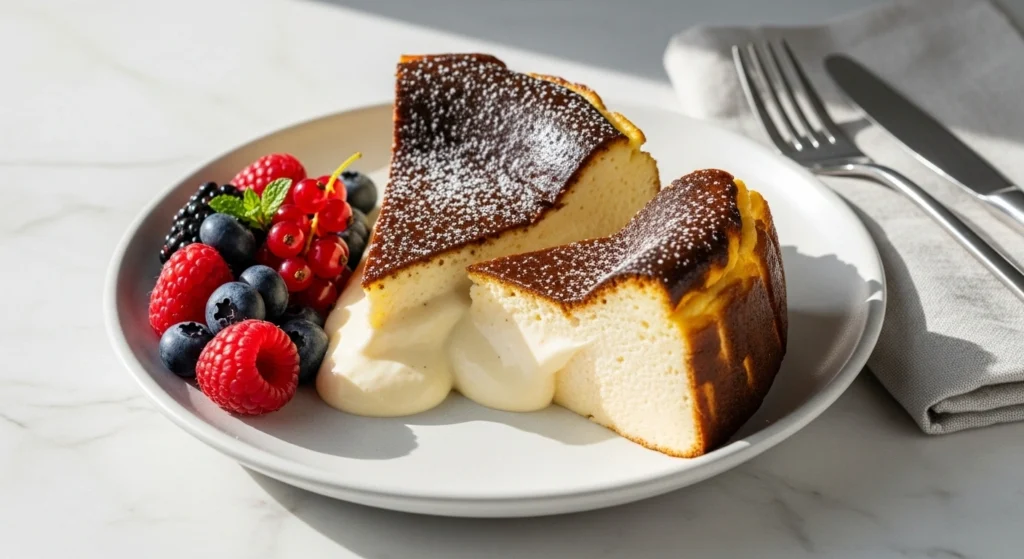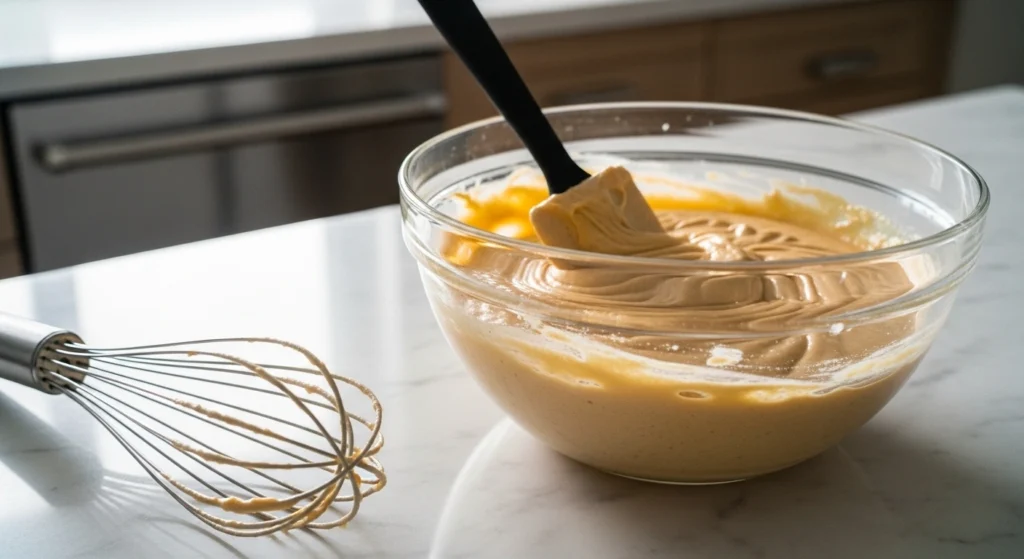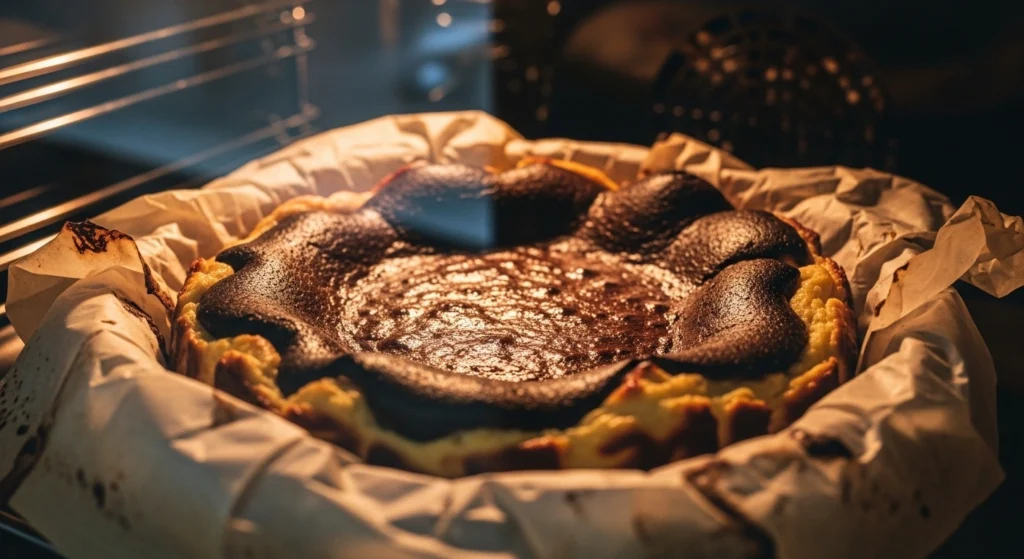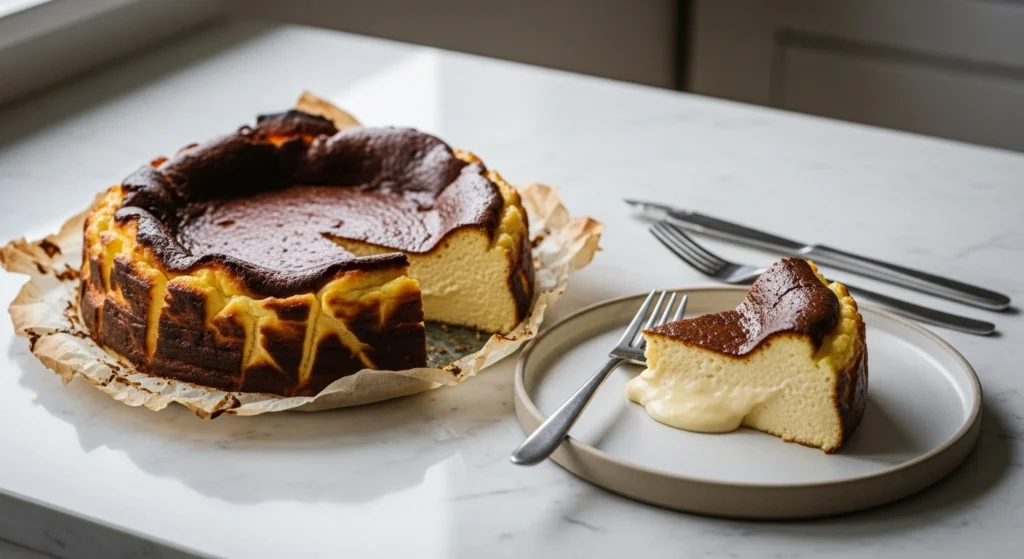
Table of Contents
The Charm of Imperfection in Every Slice
There’s something deeply satisfying about a dessert that doesn’t need to look perfect to taste extraordinary. That’s exactly what you get when you make Basque cheesecake — the rustic, crustless creation that’s taken bakeries, cafés, and home kitchens by storm. Its caramelized top and creamy center look almost accidental, but that golden “burnt” surface is what makes it stand out from every other cheesecake.
This Spanish-born treat has made its way into the spotlight not only for its striking appearance but also because it’s easier and lighter than most traditional cheesecakes. With no crust to fuss over, fewer ingredients to prepare, and a naturally gluten-free structure, it fits beautifully into today’s healthy dessert trend — one where simplicity and authenticity matter as much as taste.
What Is Basque Cheesecake and Why Everyone Is Talking About It
Originating from the Basque region of Spain, this cheesecake was first created by Chef Santiago Rivera at La Viña, a small restaurant in San Sebastián. Locals began calling it tarta de queso quemada — literally “burnt cheesecake.” Unlike New York–style cheesecakes that bake low and slow for a dense, rich texture, Basque cheesecake is baked at a high temperature so the top caramelizes quickly while the inside stays soft and creamy.
What makes this dessert so special is its balance of contrasts:
- A dark, deeply flavored top that tastes like caramelized sugar.
- A soft, silky center that almost melts on your tongue.
- The lack of a crust — which means one less step and a naturally gluten-free result.
It’s the definition of an “effortless showstopper.” And with its growing popularity across social media, coffee shops, and Michelin-starred restaurants, the Basque cheesecake isn’t just another recipe — it’s become a global dessert trend that people can’t stop baking and sharing.
Why Basque Cheesecake Is the Dessert Trend You’ll Crave
You probably don’t need convincing once you’ve seen its dramatic golden top and rustic edges, but here’s why the Basque cheesecake has become an undeniable favorite:
- It’s easier than traditional cheesecake. No water bath, no crust, and no need for a perfect top.
- It fits into modern diets. The crustless structure makes it naturally gluten-free, and it uses fewer ingredients than dense American-style versions.
- It has an authentic, home-baked charm. The imperfections are what make it beautiful.
- It’s adaptable. You can adjust sweetness, add creative flavors, or even lighten it up with yogurt or less sugar.
This dessert checks every box of current culinary trends — rustic, photogenic, easy, and with a balanced sweetness that doesn’t overwhelm.
Ingredients for a Classic Yet Healthier Basque Cheesecake
You’ll need simple, everyday ingredients to make your own Basque cheesecake, but the key is quality. Use fresh, full-fat dairy for structure and flavor, but don’t worry — you can make it slightly lighter without compromising texture.
Here’s what you’ll need:
- 750 g (about 3 blocks) cream cheese, room temperature
- 1 cup granulated sugar
- 4 large eggs (approximately 220 g when whisked)
- 1¼ cups (300 ml) heavy cream
- ¼ cup plain flour (you can use almond flour for a gluten-free version)
- 1 teaspoon pure vanilla extract
Optional health tweaks:
- Replace half the heavy cream with Greek yogurt for added protein and reduced fat.
- Cut sugar to ¾ cup if you prefer a less sweet dessert.
- Use raw cane sugar for a more complex caramel flavor.
How to Make Basque Cheesecake Step-by-Step
Step 1: Prepare Your Pan
Start by preheating your oven to 425°F (220°C).
Take a 20 cm (8-inch) springform pan and line it with parchment paper. Don’t press the paper flat — instead, crumple it first and then smooth it into the pan so the edges extend at least 2 inches above the rim. Those crinkled folds are part of the cake’s signature look.
Lightly grease the parchment with butter or cooking spray to prevent sticking.
Step 2: Mix the Batter
In a large mixing bowl, beat 750 g of cream cheese with 1 cup sugar for about 2 minutes, just until smooth. You’re not trying to whip in air — overmixing can make it too dense.
In a separate bowl, whisk together ¼ cup flour with a small portion of the 1¼ cups cream until no lumps remain. Then pour in the rest of the cream and stir until smooth.

Add the cream mixture to the cream cheese mixture slowly, whisking gently until blended.
Next, lightly whisk 4 eggs (about 220 g total), and gradually pour them into the batter. Mix just until the eggs are incorporated. Stir in 1 teaspoon vanilla extract.
The batter should be silky and fluid — thicker than heavy cream but thinner than pancake batter.
Step 3: Bake Hot, Not Long
Pour the batter into your prepared pan and tap it lightly on the counter to release air bubbles.
Place the pan on the middle rack and bake at 425°F (220°C) for 50 to 60 minutes, depending on your oven. The top should be a deep golden brown — even close to black at the edges — and the center should jiggle slightly when shaken.

Don’t panic if it looks too dark; that’s the hallmark of a proper Basque cheesecake. The “burnt” top isn’t burnt in flavor — it’s caramelized and deeply aromatic.
Step 4: Let It Cool and Set
Remove the cheesecake from the oven and allow it to cool in the pan for 2 hours.
It will deflate slightly as it cools — perfectly normal. Once it reaches room temperature, refrigerate uncovered for at least 8 hours or overnight.
This resting time is crucial. It allows the interior to firm up while keeping that creamy, custard-like center.
Before serving, carefully remove the parchment paper. Slice with a warm knife for clean cuts.
Step 5: Serve and Enjoy
Serve your Basque cheesecake slightly chilled or at room temperature.
Its flavor deepens the next day, so it’s even better after sitting in the fridge overnight.

You can serve it plain, or pair it with:
- Fresh berries or berry compote
- A drizzle of honey
- A dusting of powdered sugar
- A spoonful of Greek yogurt for contrast
Nutritional Insights — The Healthier Side of Indulgence
Each slice (based on 12 servings) provides an approximate 390–400 calories, 32 g fat, 23 g carbohydrates, and 7 g protein. The numbers might seem rich, but remember — a small slice satisfies your craving thanks to the creamy texture and balanced sweetness.
What makes it a healthier choice:
- High protein content: Eggs and cream cheese contribute natural protein.
- Lower sugar: You can cut back sugar without affecting the structure.
- No crust: Reduces refined carbs and calories.
- Fewer processed ingredients: No graham crackers or stabilizers needed.
To lighten it up, try these small adjustments:
- Use half cream, half Greek yogurt to reduce saturated fat.
- Serve smaller portions and pair with fresh fruit.
- Use organic full-fat cream cheese for cleaner ingredients.
Moderation is key — it’s still a dessert, but one that offers genuine satisfaction with fewer additives than most sweets.
Creative Twists on the Classic Basque Cheesecake
Once you’ve mastered the base recipe, you can get creative without losing that iconic texture. Here are a few ways to customize your cheesecake:
- Matcha Basque Cheesecake – Add 2 tablespoons of matcha powder to the batter for a vibrant green hue and an antioxidant boost.
- Dark Chocolate Basque Cheesecake – Melt 100 g of dark chocolate (70%) and mix it in before baking for a rich cocoa depth.
- Pumpkin Basque Cheesecake – Blend ½ cup pumpkin purée with warm spices like cinnamon and nutmeg for a cozy autumn twist.
- Yogurt Basque Cheesecake – Swap half the cream cheese for Greek yogurt to create a tangy, lighter texture.
- Mini Basque Cheesecakes – Divide the batter into muffin tins and bake for 20–25 minutes for personal-sized portions.
Each variation can adapt to your preference — whether you want it creamier, earthier, or lighter.
Pro Tips for Perfecting Your Basque Cheesecake
Avoid These Common Mistakes
- Overbaking: This leads to a dry, firm texture. Pull it out while it still jiggles slightly.
- Cold ingredients: Always bring everything to room temperature to avoid lumps.
- Under-chilling: The cheesecake must chill for several hours; otherwise, the center will be too loose.
Professional Tricks for Best Results
- Weigh your eggs. Consistency matters; aim for 220 g of whisked eggs.
- Scrunch your parchment. The folds help define the iconic rustic sides.
- Let it rest overnight. The flavor deepens and the texture sets beautifully.
- Don’t fear the burn. That caramelized surface is your best friend.
Serving, Pairing, and Storage Guide
Serving temperature: Slightly chilled or room temperature — both work beautifully.
Pairing ideas:
- Fresh raspberries or blueberries
- Espresso or black coffee
- A drizzle of salted caramel sauce
- A sprinkle of flaky sea salt on top
Storage tips:
- Store covered in the refrigerator for up to 5 days.
- Flavor improves after 24 hours.
- Avoid freezing — it changes the creamy texture.
To serve leftovers, let the cake sit at room temperature for about 20 minutes before slicing.
FAQ — Basque Cheesecake Edition
What makes Basque cheesecake different from other cheesecakes?
Unlike traditional cheesecakes, Basque cheesecake has no crust and is baked at a high temperature, giving it a dark caramelized top and a custardy center.
Can I make Basque cheesecake without flour?
Yes, it sets beautifully even without flour. You can also use almond flour if you prefer a gluten-free version.
How can I make a healthier Basque cheesecake?
Reduce sugar to ¾ cup, replace half the cream with Greek yogurt, and serve smaller slices with fresh fruit.
Why does my Basque cheesecake crack?
It’s supposed to! The cracks and burn marks give it character — they’re part of its rustic charm.
How long does Basque cheesecake last in the fridge?
Up to 5 days in an airtight container. The flavor deepens after the first day, making it even more delicious.
Conclusion — A Dessert That Redefines Simplicity and Indulgence
The beauty of the Basque cheesecake lies in its simplicity. With just a few ingredients, you create a dessert that’s rustic yet refined, rich yet balanced, familiar yet utterly new. Its slightly burnt top tells a story of boldness — of not needing perfection to achieve excellence.
This cake isn’t just a recipe; it’s a reflection of today’s healthier, more mindful approach to dessert. You can bake it once and instantly understand why it’s captivated the world. Every creamy bite reminds you that flavor, not formality, is what truly matters.
Ready to make your own Basque cheesecake? Roll up your sleeves and preheat your oven — your next favorite dessert is waiting to happen. If you bake it, share your creation with the world and tag @Delumar — because good food deserves to be celebrated.
